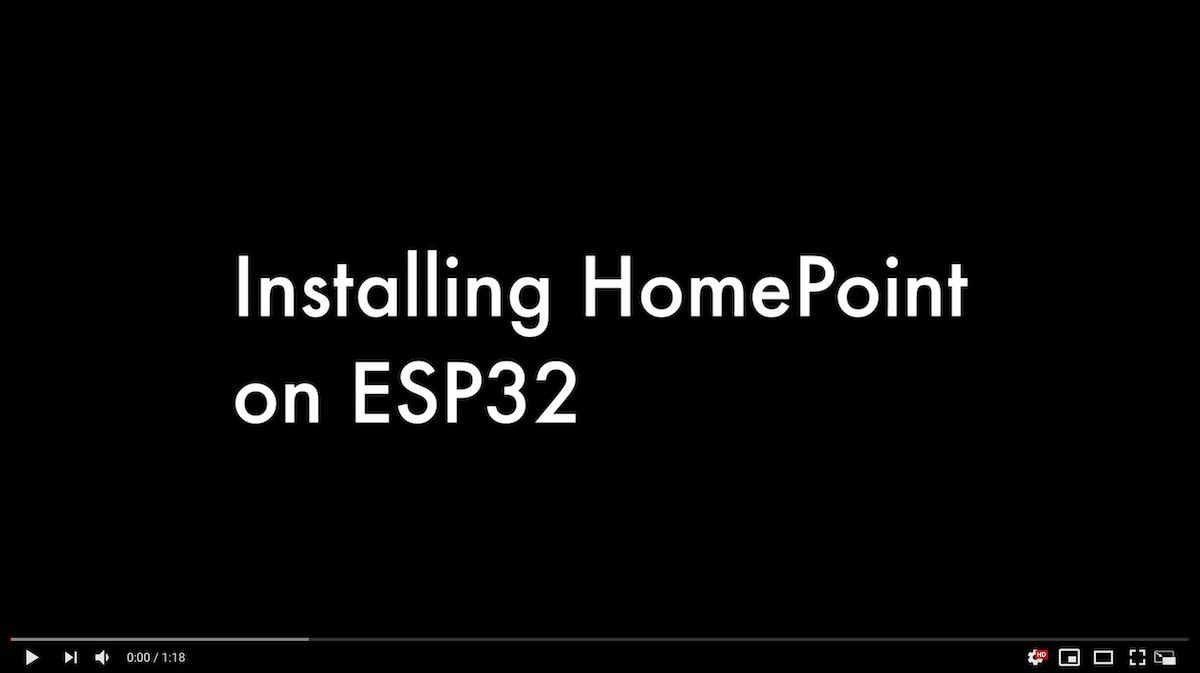Homepoint is a screen-based interface for MQTT & HomeKit-connected Smarthome devices that runs on the cheaply available ESP32 Chipset.
-
See and trigger scenes (groups of devices) on the front screen.
-
Trigger individual devices by diving into scenes (by tapping the indicator or long pressing a button).
-
See partially switched on scenes with multiple devices at a glance.
-
Support for temperature, humidity, air quality sensors & Tasmota energy readings.
-
Remote Configuration: Configure and reboot HomePoint through a web interface. No need to reflash.
-
HomeKit Switch Support (Setup Automations in Home App to toggle from Homepoint)*
-
Supports both Touch Screen or Button based navigation.
-
Reactive: Screen updates whenever devices are triggered from elsewhere.
-
Easy configuration through a JSON file, no additional code required.
-
Screensaver saves power by switching off screen after 10 minutes.
-
Statusbar shows connectivity for WiFi and MQTT as well as time.
-
Failsafe Mode: In case of corrupt configuration, failsafe mode for remote access is provided.
-
Pre-compiled binaries: Just flash HomePoint on your ESP32 device without compiling.
*currently on experimental branch.
HomePoint comes in 2 pre-compiled .bin files ready to be flashed on either a generic ESP32 Module or M5Stack. The PIN Layout required for generic ESP32 modules can be found inside the readme.txt in the releases.
Steps to install:
- Download ESPTools from https://github.com/espressif/esptool/releases
- Install ESPTools with
python setup.py install - Run
esptool.py write_flash -fs 4MB -fm dout 0x0 homepoint_espgeneric.bin(or homepoint_m5stack.bin for M5Stack)
Alternatively, watch the installation video below:
Homepoint was created using the ESP-IDF SDK.
In order to build HomePoint you need ESP-IDF from the release/v4.0 branch from the ESP-IDF git repository.
| Software | Version |
|---|---|
| ESP-IDF | release/v4.0) |
| Toolchain | 5.2.0 |
Setup your build environment if necessary:
Please refer to the documentation, especially the prerequisites but in general the steps are as follows:
On Linux:
$ mkdir ~/esp
$ cd ~/esp
$ git clone -b v4.0 --recursive https://github.com/espressif/esp-idf.git
$ cd esp-idf
$ ./install.sh
$ . ~/esp/esp-idf/export.sh
$ cd ..
Clone and build HomePoint with the following commands:
$ git clone https://www.github.com/sieren/homepoint.git
$ cd homepoint
$ git submodule update --init --recursive
$ mkdir build && cd build
$ cmake ../
$ make spiffs_spiffs_bin
$ make -j 8 flashFor use with a Button-Based interface:
$ cmake -DBUTTONS=ON ../
For out-of-the-box use with M5STACK:
$ cmake -DM5STACK=ON ../
Depending on your hardware, you may have to uncommented the relevant sections in main/libraries/TFT_ESPI/User_Setup.h.
Other Homepoint configuration settings like the Screensaver can be configured in main/config/Config.h.
The configuration lives in data/config.json.
HomePoint supports two types of Scenes with a selection of devices each:
| SCENE Types | DEVICE Types |
|---|---|
| Light, Switch | (none, all devices expected to be switches) |
| Sensor | display one or two values at once with customizable icons (singleValue / combinedValues) |
Grouped Sensors support up to two devices (due to screen space).
Lights & Switches support an infinite number of devices in a group.
Some Sensors use JSON as a data-format, in which case a key can be defined. These can be on any level of the sensor json payload, for Tasmota smart plugs the key value "Power" can be used to display the current power consumption.
WiFi and MQTT credentials are to be defined on the top level.
In order to set the correct timezone, copy & paste your NTP TZ Setting to the timezone key.
{
"wifi": "MyWifiSSID",
"password": "My Wifi Password",
"login": "admin",
"webpass": "admin",
"mqttbroker": "mqtt://192.168.1.2",
"mqttusername": "mqttusername",
"mqttpasswd": "mymqttpassword",
"timezone": "CET-1CEST-2,M3.5.0/02:00:00,M10.5.0/03:00:00",
"scenes": [{
"name": "Living Room",
"type": "Light",
"icon": "livingroom",
"devices": [{
"name": "Side Light",
"setTopic": "lights/hue/00:17:88:01:02:3c:2a:6d-0b/set/on",
"getTopic": "hue/status/lights/Hue color lamp 1",
"onValue": "true",
"offValue": "false"
}]
},
{
"name": "Bedroom",
"type": "Sensor",
"icon": "door",
"devices": [{
"name": "Temperature DHT Sensor",
"type": "singleValue",
"jsondata": true,
"firstIcon": "temperature_small",
"firstKey": "temperature",
"getTopic": "bedroom/esptemp"
},
{
"name": "Tasmota Smart Plug",
"type": "singleValue",
"jsondata": true,
"firstKey": "Power",
"firstIcon":"wattage_small",
"getTopic": "tele/DVES_2F73BE/SENSOR"
}]
}]
}A more fully-configured example is available here.
- Release 0.01
- Add Button support
- Build on CI
- Migrate to 4.0 Release Branch
- Productionize HomeKit Support
- Better NTP Time Syncing
- Add Unit-Tests
- ESP IDF 4.0 has not been released yet and is in influx. Therefore breaking changes might happen.
If you find any bugs or need assistance, don't hesitate and open an issue :)
Contributions are welcome! Just hack away and open a Pull Request. But please follow the style of the code that's already there (ie. no tabs, spacing).
I have developed HomePoint in my free time because I wanted to learn more about C++ on ESP32
and to solve a concrete problem in my smarthome.
As development kept on going, I thought about ways to make this project open source and more accessible and user-friendly for the maker-community.
If you enjoy using HomePoint or this work, consider a small donation. But don't worry, I'll continue working on this anyway ;-).
MIT © Matthias Frick







